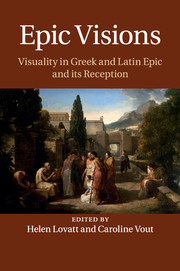57 results
5 - The Classical and Biblical in Dialogue
- from Part II - Making the Past Visible
-
-
- Book:
- Victorian Engagements with the Bible and Antiquity
- Published online:
- 28 September 2023
- Print publication:
- 12 October 2023, pp 122-158
-
- Chapter
- Export citation
An exhibition centered on an extraordinary portrait of Antinous - R. R. R. SMITH with FEDERICA GIGANTE, JULIA LENAGHAN AND MILENA MELFI, ANTINOUS: BOY MADE GOD (exhibition curated by R. R. R. Smith and Milena Melfi, 25 september 2018 – 24 February 2019; Ashmolean Museum, Oxford 2018). Pp. 128, figs. 52 (colour). ISBN 978 1 910807 27 9.
-
- Journal:
- Journal of Roman Archaeology / Volume 33 / 2020
- Published online by Cambridge University Press:
- 05 October 2020, pp. 648-652
- Print publication:
- 2020
-
- Article
- Export citation
12 - Art and the Decadent City
- from Part IV - Nero’s Monumental Rome
-
-
- Book:
- The Cambridge Companion to the Age of Nero
- Published online:
- 16 November 2017
- Print publication:
- 09 November 2017, pp 179-194
-
- Chapter
- Export citation
Afterword - Contraception in the Roman Empirea
- from 2 - A Textual Emendation in a Fragment of Musonius Rufus: A Note on Contraception*
-
-
- Book:
- Sociological Studies in Roman History
- Published online:
- 20 October 2017
- Print publication:
- 02 November 2017, pp 93-104
-
- Chapter
- Export citation
Contributors
-
-
- Book:
- Art and Rhetoric in Roman Culture
- Published online:
- 05 October 2014
- Print publication:
- 02 October 2014, pp xvi-xvii
-
- Chapter
- Export citation
9 - The funerary altar of Pedana and the rhetoric of unreachability
- from Part III - The Funerary
-
-
- Book:
- Art and Rhetoric in Roman Culture
- Published online:
- 05 October 2014
- Print publication:
- 02 October 2014, pp 288-315
-
- Chapter
- Export citation
Index locorum
-
- Book:
- Epic Visions
- Published online:
- 05 February 2015
- Print publication:
- 15 August 2013, pp 321-322
-
- Chapter
- Export citation
Contents
-
- Book:
- Epic Visions
- Published online:
- 05 February 2015
- Print publication:
- 15 August 2013, pp vii-ix
-
- Chapter
- Export citation
Epic Visions - Title page
-
-
- Book:
- Epic Visions
- Published online:
- 05 February 2015
- Print publication:
- 15 August 2013, pp iii-iii
-
- Chapter
- Export citation
Dedication
-
- Book:
- Epic Visions
- Published online:
- 05 February 2015
- Print publication:
- 15 August 2013, pp v-vi
-
- Chapter
- Export citation
Bibliography
-
- Book:
- Epic Visions
- Published online:
- 05 February 2015
- Print publication:
- 15 August 2013, pp 283-320
-
- Chapter
- Export citation
8 - Epic in the round
-
-
- Book:
- Epic Visions
- Published online:
- 05 February 2015
- Print publication:
- 15 August 2013, pp 191-217
-
- Chapter
- Export citation
Introduction
-
-
- Book:
- Epic Visions
- Published online:
- 05 February 2015
- Print publication:
- 15 August 2013, pp 1-31
-
- Chapter
- Export citation
Epic Visions - Half title page
-
- Book:
- Epic Visions
- Published online:
- 05 February 2015
- Print publication:
- 15 August 2013, pp i-ii
-
- Chapter
- Export citation
Abbreviations
-
- Book:
- Epic Visions
- Published online:
- 05 February 2015
- Print publication:
- 15 August 2013, pp xviii-xviii
-
- Chapter
- Export citation
Copyright page
-
- Book:
- Epic Visions
- Published online:
- 05 February 2015
- Print publication:
- 15 August 2013, pp iv-iv
-
- Chapter
- Export citation
Contributors
-
-
- Book:
- Epic Visions
- Published online:
- 05 February 2015
- Print publication:
- 15 August 2013, pp xiv-xvi
-
- Chapter
- Export citation
General index
-
- Book:
- Epic Visions
- Published online:
- 05 February 2015
- Print publication:
- 15 August 2013, pp 323-327
-
- Chapter
- Export citation

Epic Visions
- Visuality in Greek and Latin Epic and its Reception
-
- Published online:
- 05 February 2015
- Print publication:
- 15 August 2013
Figures
-
- Book:
- Epic Visions
- Published online:
- 05 February 2015
- Print publication:
- 15 August 2013, pp x-xii
-
- Chapter
- Export citation



